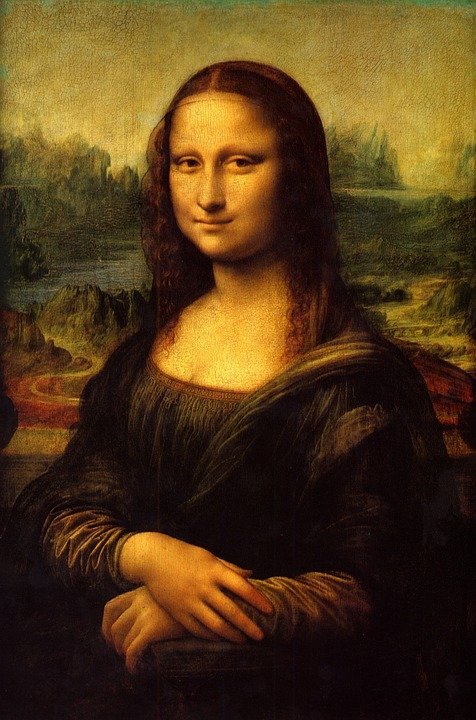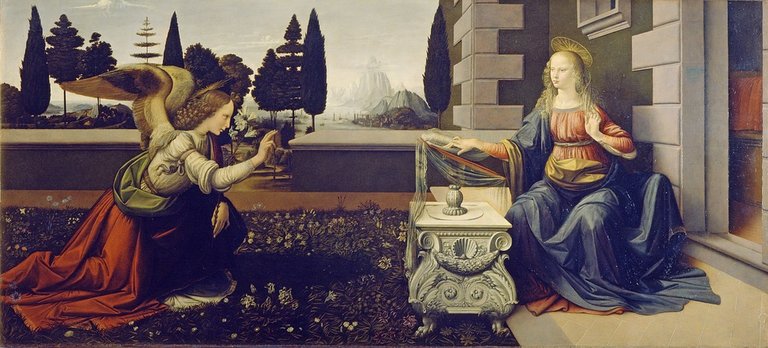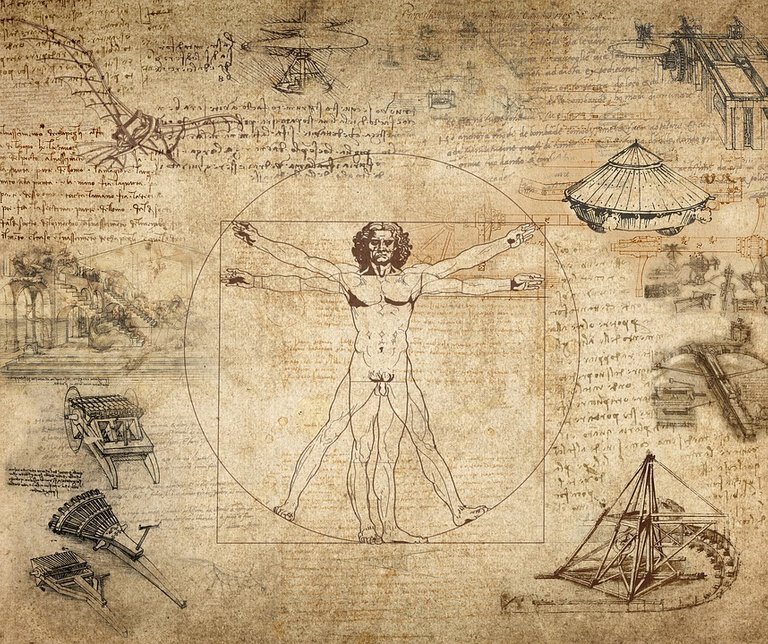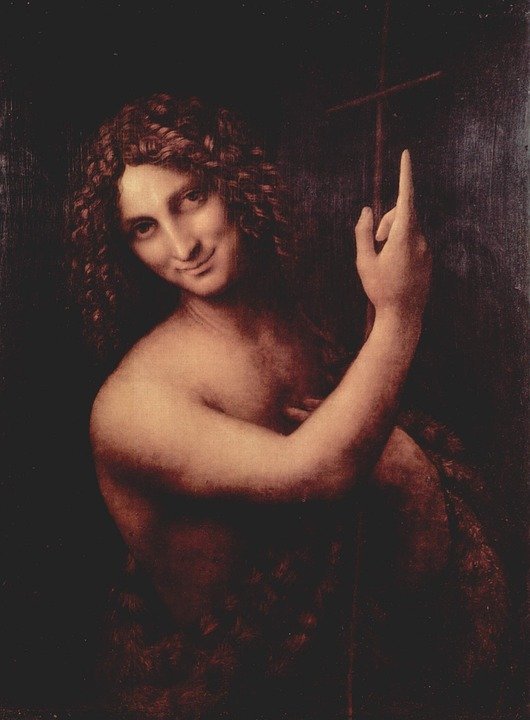6 genialidades de Leonardo Da Vinci / 6 Geniuses of Leonardo Da Vinci
A 502 años de su muerte, recordamos a Leonardo Da Vinci con 6 de sus obras más destacas en la historia del arte.
502 years after his death, we remember Leonardo Da Vinci with 6 of his most outstanding works in the history of art.

Un saludo a todos los Hive amigos que visitan mi blog.
El 2 de mayo de 1519 muere el sabio renacentista, Leonardo Da Vinci, muerte que tradicionalmente se cree que murió en brazos de Francisco I, debido a un epígrafe escrito por el historiador de arte, Giorgio Vasari, donde dice que Da Vinci "expirar sobre el pecho de un rey" sin embargo, esto también puede referirse de manera metafórica a que el pintor murió en Castillo Real.
Con su muerte, muchos fueron los documentos extraviados que hablan sobre la vida y obra de este importante personaje artístico. Aun así, de sus obras más conocidas hay 6 que muestras la genialidad de Da Vinci de manera irrefutable, y eso precisamente es lo que vengo a compartir con todo ustedes hoy. Espero que lo disfruten tanto como yo.
Greetings to all Hive friends who visit my blog.
On May 2, 1519 dies the Renaissance scholar, Leonardo Da Vinci, death traditionally believed to have died in the arms of Francis I, due to an epigraph written by the art historian, Giorgio Vasari, where he says that Da Vinci "expire on the chest of a king " however, this may also refer metaphorically to the painter died in Royal Castle.
With his death, many were the lost documents that speak about the life and work of this important artistic character. Even so, there are 6 of his best known works that show the genius of Da Vinci in an irrefutable way, and that is precisely what I come to share with all of you today. I hope you enjoy it as much as I do.

La mona lisa / The smooth monkey
Llamada también como "La Gioconda" ya que es el retrato de Lisa Gherardini, la esposa de Francesco del Giocondo, de ahí también sale el popular nombre de esta obra "la mona lisa", donde mona en italiano se refiere a señora.
Esta obra es considerada la más importante del mundo y fue adquirida por el Rey Francisco I a principios del siglo XVI. Es propiedad del Estado francés y se exhibe en el museo Louvre de Paris, ambientado a temperatura estable para su preservación optima con un múltiples sistemas de seguridad para su resguardo.
Also known as "La Gioconda" because it is the portrait of Lisa Gherardini, the wife of Francesco del Giocondo, hence the popular name of this work "la mona lisa", where mona in Italian refers to lady.
This work is considered the most important in the world and was acquired by King Francis I in the early sixteenth century. It is property of the French State and is exhibited in the Louvre Museum in Paris, set at a stable temperature for its optimal preservation with multiple security systems for its safekeeping.
La Última Cena / The Last Supper
Fue pintada en una pared del refectorio del convento dominico de Santa María delle Grazie en Milán, Italia, donde permanece actualmente.
Es considerada una de las obras más magnificas de la historia ya que refleja uno de los momentos más importantes del catolicismo como lo es, la última cena de Jesucristo con sus 12 apóstoles
Ha sido objeta de polémica, luego de que el escritor Dan Brown, en su novela "El código Da Vinci", asegurara que el personaje de la derecha no es el apóstol Juan, sino una mujer. Esta teoría ha sido desmentida con dibujos previos de Da Vinci, donde retrata al aposto más joven y coincide con el aspecto que se le ve en esta obra.
It was painted on a wall of the refectory of the Dominican convent of Santa Maria delle Grazie in Milan, Italy, where it remains today.
It is considered one of the most magnificent works in history as it reflects one of the most important moments of Catholicism, the last supper of Jesus Christ with his 12 apostles.
It has been the subject of controversy, after the writer Dan Brown, in his novel "The Da Vinci Code", said that the character on the right is not the apostle John, but a woman. This theory has been disproved with previous drawings of Da Vinci, where he portrays the younger apostle and coincides with the aspect that is seen in this work.
Anunciación / Annunciation Annunciation
Pintada al oleo sobre madera, mide unos 100 cm de alto y 221 cm de ancho y se conserva en la Galeria de los Uffizi de Florencia, Italia. Es catalogado como uno de los cuadros más celebres del pintor.
Algunos expertos cuestionan el error de perspectiva cometido por Da Vinci en esta obra, el cual se puede apreciar en la desproporción de longitud en el brazo de la virgen. Error que no se visualiza en la versión del cuadro que reposa en el Museo del Louvre.
Painted in oil on wood, it is about 100 cm high and 221 cm wide and is preserved in the Uffizi Gallery in Florence, Italy. It is considered one of the painter's most famous paintings.
Some experts question the perspective error made by Da Vinci in this work, which can be seen in the disproportion of length in the arm of the virgin. This error is not visible in the version of the painting that rests in the Louvre Museum.
Hombre de Vitruvio / Vitruvian Man
Es el reflejo de un estudio del artistas, sobre las proporciones del cuerpo humano, el cuadro esta acompañado de notas anatómicas tomadas por Da vinci basados en los textos del arquitecto de la antigua Roma Vitruvio.
la mala noticia con esta obra es que, por su atípica naturaleza, pocas veces son exhibidas al pública por lo cual resulta muy difícil que en algún momento la podamos ver en vivo
It is the reflection of a study of the artist, on the proportions of the human body, the painting is accompanied by anatomical notes taken by Da Vinci based on the texts of the architect of ancient Rome Vitruvius.
The bad news with this work is that, due to its atypical nature, it is rarely exhibited to the public, making it very difficult to see it live at some point in the future.
La dama del armario / The lady in the closet
Leonardo Da Vinci solo pinto cuatro retratos de mujer, este es uno de ellos, y pertenece a Cecilia Gallerani quien fue retratada por Da Vinci cuando era la amante de Ludovico Sforza, duque de Milán, de ahí se puede deducir el nombre de la obra.
Como dato curioso de esta pintura, se puede decir que la película polaca "Vinci" gira en torno al robo de esta obra, pero no es único film que incluye el retrato dentro de su rodaje, ya que en “Patria”, de Robert Harris, forma parte esencial de la trama de la película.
Leonardo Da Vinci only painted four portraits of women, this is one of them, and belongs to Cecilia Gallerani who was portrayed by Da Vinci when she was the mistress of Ludovico Sforza, Duke of Milan, hence the name of the work can be deduced.
As a curious fact about this painting, it can be said that the Polish film "Vinci" revolves around the theft of this work, but it is not the only film that includes the portrait in its shooting, as in "Homeland", by Robert Harris, it is an essential part of the plot of the film.
San Juan Bautista
Este fue uno de los últimos cuadros pintados por Da Vinci, creado entre 1508 y 1513, en plena época del alto renacimiento, fue pintado en oleo y se conserva en el Museo Louvre de Francia.
Este cuadro ha sido uno de los más polémicos en relación al significado del dedo de San Juan Batista apuntando hacia arriba y su enigmática sonrisa, lo que ha generado debates similares a los ocasionados por "La mona lisa" y se ha cuestionado la imagen como hermafrodita.
En el retrato se le ve al santo, de medio cuerpo, con pelo largo y rizado, vestido de pieles y con una cruz de junco en la mano izquierda, pero existe la creencia que tanto las pieles como la cruz fueron agregadas más adelante por otro pintor.
This was one of the last pictures painted by Da Vinci, created between 1508 and 1513, at the height of the Renaissance, was painted in oil and is preserved in the Louvre Museum in France.
This painting has been one of the most controversial in relation to the meaning of St. John the Baptist's finger pointing upwards and his enigmatic smile, which has generated debates similar to those caused by "The Smooth Monkey" and the image has been questioned as a hermaphrodite.
The portrait shows the saint, half-length, with long curly hair, dressed in furs and holding a reed cross in his left hand, but it is believed that both the furs and the cross were added later by another painter.

El arte es simplemente maravillosa, es la mejor forma de expresión que conozco y aunque la pintura no es mi fuerte, siempre he admirado las obras de Leonardo da Vinci, y para mi fue un verdadero genio del arte.
Disfrute mucho la realización de este post y me acerco aún más a mi amor por las artes en general, lo que me hace inmensamente feliz.
A todo los que leyeron y disfrutaron este post, muchas gracias.
Art is simply wonderful, it is the best form of expression I know and although painting is not my forte, I have always admired the works of Leonardo da Vinci, and for me he was a true genius of art.
I really enjoyed making this post and it brought me even closer to my love for the arts in general, which makes me immensely happy.
To all who read and enjoyed this post, thank you very much.

Todas las imágenes y separadores de texto son de mi propiedad excepto las que indican la fuente
All images and text separators are my property except those that indicate the source
Gracias por tu lectura y si te gustó no olvides dejar tu voto y comentar
Thank you for your reading and if you liked it don't forget to leave your vote and comment
Texto original de
Original text from







.jpg)
